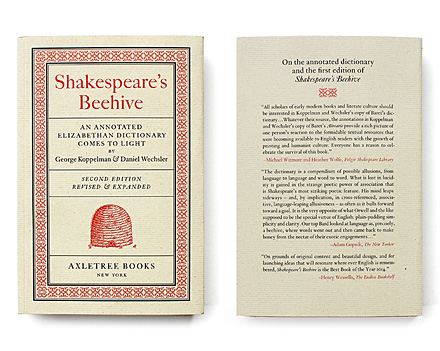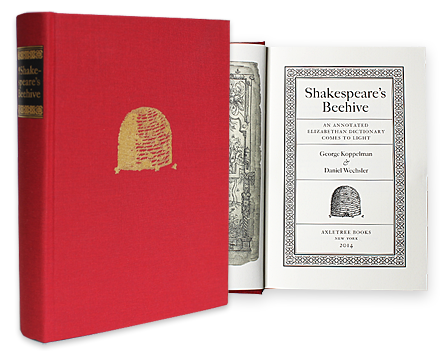June 6, 2014
Why the Interest in the Yew Tree?
One of the words that captured the greatest amount of attention, and possibly even the imagination, of the annotator of the Baret is the “Yew” tree. In our study, we interpreted three of the annotations that are penned beside the variant spellings as “IHS” monograms, entered to imply the association with Christ and the wood used for the cross.



In the first posted reply to the Folger’s Michael Witmore and Heather Wolfe’s piece, “Buzz or honey? Shakespeare’s Beehive raises questions,” Erin Blake correctly notes that the French word “If” means “Yew” tree. In the first of the three images shown, one can see that the French “If” is printed in Baret under the “Yew” spelling (but not under the “Ugh” and “Ewe” spellings). This was an oversight on our part and we are grateful to Erin for having pointing it out.
The second and third annotations have been revised to now read “If”. The second annotation is the clearest representation of the “If” intended as the French equivalent word, as it is followed by the Latin and Middle English “arbor” (arbour) for “tree”, and also mimics the typography of the entry (“1f”) as printed under “Yew” (see first image). These second and third annotations follow the pattern of the annotator occasionally adding the French at either a “Vide” word synonym, or an alternate spelling of the same word, when it is printed in one location but not at another.
In the first annotation, however, the annotator does not seem satisfied with leaving the “If” to complete the thought, and, in fact, it would be redundant to place such an annotation there at all, as the word is already printed in the Baret as part of the definition, and therefore it would not bear duplicating the entry within the column. In this most carefully executed annotation, there looks to be a concerted effort to create an IHS monogram, or even to transform the “If” into an “IHS”. Regardless of whether one is convinced by this argument, both the care and the dots added to each side of the annotation (a common practice by early modern annotators, but not in any way used systematically by our annotator), reflect considerable playfulness, as does the fact that each of the three entries not only receives attention, but is treated with variable approaches.
Why should the annotator be so concerned with the yew tree? Of course, there could be many reasons, but the attention is clearly indicative of serious interest, whether or not the extra care given to the one annotation in particular further supports the possibility that it was intended as a religious marker with personal meaning. If the intention was to create an IHS monogram, the cross above the letters that is usually found in the Jesuit usage of the monogram is absent, but perhaps can be represented by the yew tree itself.
Shakespeare uses “yew” six times in the works, including the famous brew of the weird sisters at the start of Macbeth:
“Gall of goat, and slips of yew
Sliver’d in the moon’s eclipse…”
A yew tree was said to have grown in his yard in Stratford. No doubt Shakespeare was familiar with both its medicinal properties and the association with Christ and the wood used for the cross. “Hebana” or “henbane” was an alternate word for yew, and this word in the Baret has been marked by our annotator with a slash at H391: / Henbane herbe.
In a detailed book that explores botanical usages in the works, The Plant Lore and Garden-Craft of Shakespeare (1896), Henry Ellacombe relates this alternate word for yew with the depiction of poisoning from the plant that Hamlet hears from his father’s ghost (“..with juice of cursed hebona…”). Ellacombe writes:
“It may well be asked, how could Shakespeare have known of all these effects, which (as far as our present search has discovered) are not named by any one writer of his time, and some of which have only been made public from the results of Yew-poisoning since his day? I think the question can be answered in a very simple way. The effects are described with such marked minuteness that it seems to me not only very probable, but almost certain, that Shakespeare must have been an eye-witness of a case of Yew-poisoning, and that what he saw had been so photographed on his mind that he took the first opportunity that presented itself to reproduce the picture. With his usual grand contempt for perfect accuracy he did not hesitate to sweep aside at once the strict historical records of the old king’s death, and in its place to paint for us a cold-blooded murder carried out by means which he knew from his personal experience to be possible, and which he felt himself able to describe with a minuteness which his knowledge of his audiences assured him would not be out of place even in that great tragedy.”[i]
Whether or not Shakespeare ever witnessed for himself the results of yew poisoning as Ellacombe intuits, the most serious potential interest here, as far as Shakespeare’s life is concerned, falls into the Catholicity debate, sometimes characterized as Lancastrian Shakespeare.[ii] To make matters potentially more complicated still, beyond whether the annotation beneath the “Yew” tree entry at Y31 is to be seen as an IHS monogram or a reworking of “If” into an IHS monogram, the annotator draws a slash line at S191 above the printed word Shake and enters “shaft,”producing the intriguing composition Shakeshaft.

The speculation behind the theory of Shakespeare as schoolmaster in Lancashire under the name “Shakeshafte” is part of the scholarship related to Catholicity, and Shakespeare’s possible recusant sympathies. Commentators have suggested that if indeed William Shakeshafte was William Shakespeare, the use of the name Shakeshafte was itself a sign of his wariness and the distance he preferred to keep from the Cottam and Campion circles. We do not find other annotation evidence in our Baret that would hint at any further connections, but feel there has been enough intrigue raised by scholars to warrant those annotations discussed here as being deserving of attention.
[i] Henry N. Ellacombe, The Plant-Lore and Garden-Craft of Shakespeare (London: Edward Moxon, 1896), 125.
[ii] The most comprehensive survey of the Lancastrian Shakespeare discoveries can be found in Richard Wilson’s Secret Shakespeare: Studies in Theatre, Religion, and Resistance (Manchester, UK: Manchester University Press, 2004).
Please also see: http://collation.folger.edu/2014/04/buzz-or-honey-shakespeares-beehive-raises-questions/
For Beehive Blog updates, follow us on Facebook and Twitter.



